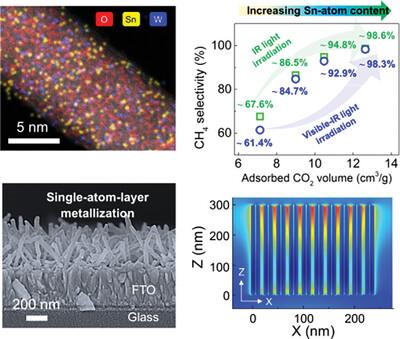当前位置:
X-MOL 学术
›
Adv. Mater.
›
论文详情
Our official English website, www.x-mol.net, welcomes your
feedback! (Note: you will need to create a separate account there.)
Single-Atom-Layer Metallization of Plasmonic Semiconductor Surface for Selectively Enhancing IR-Driven Photocatalytic Reduction of CO2 into CH4
Advanced Materials ( IF 27.4 ) Pub Date : 2024-11-20 , DOI: 10.1002/adma.202413931 Na Lu, Xiaoyi Jiang, Yongan Zhu, Linqun Yu, Shiwen Du, Jindou Huang, Zhenyi Zhang
Advanced Materials ( IF 27.4 ) Pub Date : 2024-11-20 , DOI: 10.1002/adma.202413931 Na Lu, Xiaoyi Jiang, Yongan Zhu, Linqun Yu, Shiwen Du, Jindou Huang, Zhenyi Zhang

|
Efficient harvesting and utilization of abundant infrared (IR) photons from sunlight is crucial for the industrial application of photocatalytic CO2 reduction. Plasmonic semiconductors have significant potential in absorbing low-energy IR photons to generate energetic hot electrons. However, modulating these hot electrons to selectively enhance the activity of CO2 reduction into CH4 remains a challenge. Herein, the study proposes a single-atom-layer (SAL) metallization strategy to enhance the generation of IR-driven hot electrons and facilitate their transfer from plasmonic semiconductors to CO2 for producing CH4. This strategy is demonstrated using a paradigmatic W18O49@W-Sn nanowire array (NWA), where Sn2+ ions are grafted onto exposed O atoms on the surface of plasmonic W18O49 to form a surface W-Sn SAL. The incorporation of Sn single atoms enhances plasmonic absorption in IR light for W18O49 NWA. The W-Sn SAL not only promotes CO2 adsorption and reduces its reaction activation energy barrier but also shifts the endoergic CO-protonation process toward an exoergic reaction pathway. Thus, the W18O49@W-Sn NWA exhibits >98% selectivity for IR-driven CO2 reduction to CH4 with an activity over 9.0 times higher than that of bare W18O49 NWA. This SAL metallization strategy can also be applied to other plasmonic semiconductors for selectively enhancing CO2-to-CH4 reduction reactions.
中文翻译:

等离子体半导体表面的单原子层金属化,用于选择性增强红外驱动的光催化将 CO2 还原为 CH4
从阳光中有效收集和利用丰富的红外 (IR) 光子对于光催化 CO2 还原的工业应用至关重要。等离子体半导体在吸收低能红外光子以产生高能热电子方面具有巨大潜力。然而,调节这些热电子以选择性地增强 CO2 还原为 CH4 的活性仍然是一个挑战。在此,该研究提出了一种单原子层 (SAL) 金属化策略,以增强 IR 驱动的热电子的产生,并促进它们从等离子体半导体转移到 CO2 以产生 CH4。使用典型的 W18O49@W-Sn 纳米线阵列 (NWA) 演示了这种策略,其中 Sn2+ 离子被接枝到等离子体 W18O49 表面暴露的 O 原子上,形成表面 W-Sn SAL。Sn 单原子的掺入增强了 W18O49 NWA 在红外光中的等离子体吸收。W-Sn SAL 不仅促进 CO2 吸附并降低其反应活化能屏障,而且还将内能 CO 质子化过程转向外能反应途径。因此,W18O49@W-Sn NWA 对红外驱动的 CO2 还原到 CH4 的选择性为 >98%,其活性是裸 W18O49 NWA 的 9.0 倍以上。这种 SAL 金属化策略也可以应用于其他等离子体半导体,以选择性地增强 CO2 到 CH4 还原反应。
更新日期:2024-11-20
中文翻译:

等离子体半导体表面的单原子层金属化,用于选择性增强红外驱动的光催化将 CO2 还原为 CH4
从阳光中有效收集和利用丰富的红外 (IR) 光子对于光催化 CO2 还原的工业应用至关重要。等离子体半导体在吸收低能红外光子以产生高能热电子方面具有巨大潜力。然而,调节这些热电子以选择性地增强 CO2 还原为 CH4 的活性仍然是一个挑战。在此,该研究提出了一种单原子层 (SAL) 金属化策略,以增强 IR 驱动的热电子的产生,并促进它们从等离子体半导体转移到 CO2 以产生 CH4。使用典型的 W18O49@W-Sn 纳米线阵列 (NWA) 演示了这种策略,其中 Sn2+ 离子被接枝到等离子体 W18O49 表面暴露的 O 原子上,形成表面 W-Sn SAL。Sn 单原子的掺入增强了 W18O49 NWA 在红外光中的等离子体吸收。W-Sn SAL 不仅促进 CO2 吸附并降低其反应活化能屏障,而且还将内能 CO 质子化过程转向外能反应途径。因此,W18O49@W-Sn NWA 对红外驱动的 CO2 还原到 CH4 的选择性为 >98%,其活性是裸 W18O49 NWA 的 9.0 倍以上。这种 SAL 金属化策略也可以应用于其他等离子体半导体,以选择性地增强 CO2 到 CH4 还原反应。


















































 京公网安备 11010802027423号
京公网安备 11010802027423号